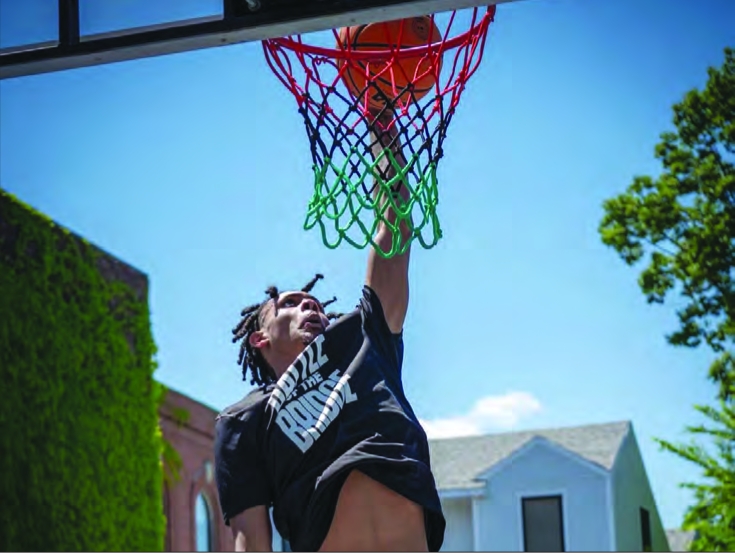
(top
right) These customized basketball nets were inspired by the colors of
Marcus Garvey’s Pan-African Flag. (above) Gaines wants to merge art with
athleticism and heritage through his basketball hoops.

In a city rich with history and known for its cultural tapestry, some of Boston’s basketball courts received a makeover for June. Inspired by icons like Marcus Garvey and Lebron James, a pioneering art project is taking shape under the creative vision of Glen Gaines.
In celebration of Black history, Glen Gaines has been putting up customized basketball nets adorned with the colors of Marcus Garvey’s Pan-African flag. “I was always seeing either the all-white nets or the American flag nets growing up playing basketball. Then I paired that with one of my favorite pieces by David Hammonds called African American Flag,” Gaines said of his inspiration.
“I wanted to create something that resonates and also reflects our community,” Gaines stated. “The hoops are more than just basketball equipment; they represent revelation, unity, ownership, and a sense of pride in your identity.”
With a professional background in art handling, Gaines was aware of the possible pushback on the city almost immediately. The city’s initial pushback affirmed his fear but also motivated him to spread his message throughout the Greater Boston area.
Speaking of his inspiration, Gaines recalls seeing a photo of a young Lebron James shooting on a dyed net. “He was shooting on a Fisher Price, and the color of the net was red, white and blue, and that really stuck with me. I was always seeing either the all-white nets or the American flag nets growing up playing basketball. Then I paired that with one of my favorite pieces by David Hammonds, called “African American Flag.”
The idea for the installation began in October of 2023, and Gaines has spent the following nine months designing, manufacturing and installing these nets across the city. Although it started with three different basketball hoops glued together – one dyed green with hair dye – this project has now culminated into a striking display that combines sports, arts and identity.
“I started by creating my own sample by finding an all-black net and an all-red net, and then I found an all-white net. I had to dye it with green hair dye, and then I just glued each piece together,” Gaines said of the inception of his idea. “After finding out that this isn’t anything that I can handmake — it’s machinery work that makes them — I used the time between October and January to find a manufacturer. Then, I began the process of trying to collaborate with the city.”
Securing funding from the city of Boston proved to be a hurdle. City officials told Gaines that despite the significance of his idea, they were used to spending only $350 on nets citywide, and to pursue his idea would be out of the city’s Parks and Recreation budget.
“At first, I approached it as a vendor or an independent contractor, but once I got denied and had been given every single excuse
in the book, I thought it was time to get some political backing,” said
Gaines. “I had the infamous Rucker Park supporting it too. Obviously,
this is bigger than just Boston,” Gaines said.
Undeterred
by these setbacks, Gaines reached out to politicians directly and
consistently in hopes that this project would resonate with them. This
included hand-delivering nets to representatives from Springfield and
conversations with city officials directly about the invaluable nature
of this project.
“I
think that there are multiple reasons it wasn’t seen as valuable. I
thought that it made sense to begin that process in Black History
Month.” Gaines said. The installation’s timing during Black History
Month added significance to its message, underscoring the importance of
empowerment in the Black community, but it also speaks to a certain
level of commercialization of Black identity that Gaines quickly picked
up on.
Looking ahead,
Gaines hopes that his initiative sparks conversations in neighborhoods
where activism seems more performative than anything else.
By
merging art with athleticism and heritage, the dyed basketball hoops
serve as a reminder of Boston’s diverse identity and the power of
artistic expression.
Bostonians
can look forward to experiencing these transformed courts firsthand in
neighborhoods like Cambridge, Brockton and Springfield, which have all
embraced this idea. More
than just a visual spectacle, the project invited residents and visitors
alike to reflect on the city’s history through a creative lens,” Gaines
said.
“This isn’t
just about painting hoops,” Gaines explained. “Boston is a city built on
the backs of Black people. I think it is so important that citizens and
the city recognize that. And the worst somebody could do is look away,
so there is virtually no downside.”
Speaking
of his audience, Gaines explained that through his background in art
handling, he quickly learned that “art is either something that is liked
or shunned. If someone wants to look away, that’s fine because there is
also somebody that it sticks with. That was my goal, to have this
stick. To have the ideas of revelation, pride in our identity, and
ownership . . . stick.”
Gaines
hopes to continue this effort outside of the month of June and outside
of Boston. Now, he is selling these nets online in hopes of building a
stronger connection with a consumer base, not just the city of Boston.
This initiative by Gaines underscores Boston’s rich cultural history and
the impact that Black communities have had in building Boston into the
city it is today.